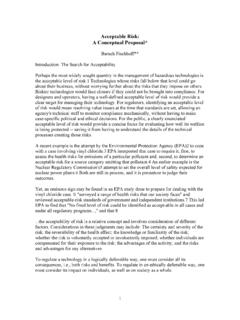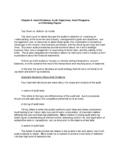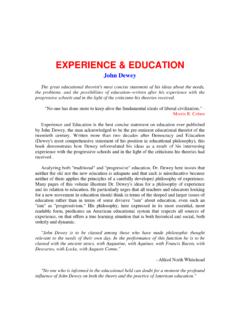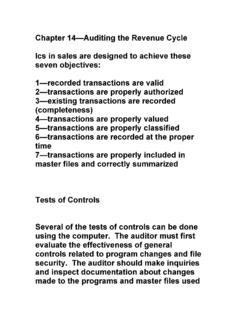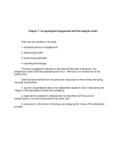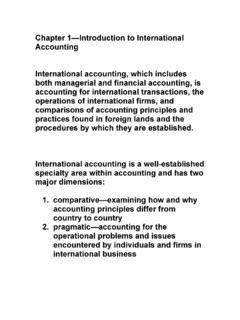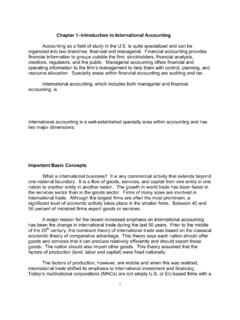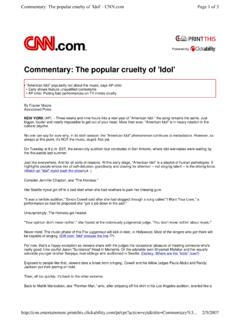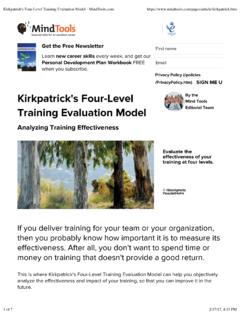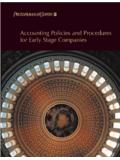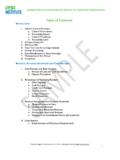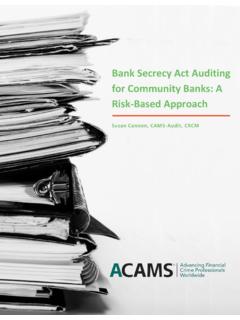Transcription of Chapter 18–Auditing Investments and Cash Balances
1 Chapter 18 auditing Investments and Cash Balances General Considerations Cash Balances include undeposited receipts on hand, cash in bank in unrestricted accounts, and imprest accounts such as petty cash and payroll bank accounts. The five transaction cycles which relate directly to general cash Balances are revenue, expenditure, financing, investing, and personnel services. This Chapter relates primarily to substantive tests for cash Balances . Hence, the account balance audit objectives shown in Fig.
2 18-5 are those for cash: E or O did recorded cash Balances exist at the balance sheet date/ Completeness are the effects of all cash transactions included in cash? Are year-end account transfers recorded in the proper period? R and O does the client have legal title to all cash shown on the balance sheet? V or A does cash on the balance sheet match supporting schedules? P and D are cash Balances properly classified? Are lines of credit, loan guarantees, compensating balance agreements, and other restrictions disclosed properly?
3 Materiality, Risk, and Audit Strategy Key point the high volume of transactions that go through cash creates a high level of inherent risk for the E or O and completeness assertions. Auditors tend to conduct an extensive amount of substantive tests on cash. Substantive Tests of Cash Balances Determining Detection Risk The nature, timing, and extent of substantive tests on cash can be varied extensively to be commensurate with varying risk levels. Auditors need to consider control risk assessments for cash receipts and disbursements in each cycle in addition to inherent risk.
4 Substantive Tests Design Let s consider Fig. 18-6 as it contains many substantive tests of cash balance assertions. Initial Procedures Tracing the current period s starting Balances to the ending audited Balances in the prior year s working papers is the starting point for verifying cash Balances . Second, the auditor should review the current period s activity in the G/L cash accounts for unusual entries. Client summaries of undeposited cash receipts should be analyzed. Analytical Procedures Various cash ratios should be computed and analyzed for signals of possible manipulation.
5 Such an analysis can provide evidence for the E or O, completeness, and V or A assertions. Tests of Details of Transactions Perform Cash Cutoff Tests A proper cutoff of cash receipts and disbursements at year end is vital to the proper statement of cash at the balance sheet date. Two cash cutoff tests to perform are a cash receipts cutoff test and a cash disbursements cutoff test. The assertions addressed are E or O and completeness. Trace bank Transfers Many entities maintain accounts with more than one bank .
6 Thus, an entity may transfer money between banks. A transfer usually involves float. Cash on deposit per bank records will be overstated during the float period because the check will be included in the balance of the bank in which it is deposited and will not be deducted from the bank on which it is drawn. Intentionally recording a bank transfer as a deposit in the receiving bank while failing to show a deduction from the bank account on which the transfer check is drawn is kiting. Auditors prepare a bank transfer schedule as evidence of the validity of bank transfers or of misstatements therein.
7 Data for the schedule are obtained from an analysis of the cash entries per books and applicable bank and cutoff bank statements. Consider Fig. 18-7 in your textbook. Kiting is possible when internal control weaknesses permit one person to issue and record checks or collusion exists between the two people who are responsible for the two functions. Kiting may be detected by obtaining and using a bank cutoff statement because a kited check clearing in January will not appear on the list of outstanding checks for December and performing a cash cutoff test because the last check issued in December will not be recorded in the check register.
8 Prepare a Proof of Cash A proof of cash is A proof of cash permits a reconciliation of four bank and book items: beginning Balances , cash receipts transactions, cash disbursements transactions, and ending cash Balances . Fig. 18-A1 shows one example of a proof of cash working paper. Tests of Details of Balances We need to consider five commonly used substantive tests of cash Balances : 1 Count Cash on Hand The auditor needs to do the following to properly perform a cash count: This test provides evidence about each of the five financial statement assertions except P & D.
9 2 Confirm bank Deposit and Loan Balances It is customary for the auditor to obtain a bank confirmation for cash on deposit and loan Balances at the balance sheet date. Take a look at Fig. 18-6. bank confirmation requests should be sent to all banks in which the client has an account, including those that may have a zero balance . The confirmation of cash provides evidence for the following two assertions: The confirmation of loan Balances provides evidence for the following three assertions: 1-existence or occurrence because there is written acknowledgment that the loam balance exists 2-rights and obligations because the loan is a debt of the client 3-valuation or allocation because the response indicates the amount of the loan balance 3 Confirm Other Arrangements with Banks Some borrowers must maintain a compensating balance as part of a credit facility or loan arrangement with a bank .
10 Also, a contingent liability may exist when the client is the guarantor of a loan made by the bank to a third party. Any confirmation sent to a financial institution concerning a compensating balance or guaranty should be signed by the client. 4 Scan, Review, or Prepare bank Reconciliations When the acceptable level of detection risk is high, the auditor may scan the client-prepared bank reconciliation and verify the mathematical accuracy of the reconciliation. If detection risk is moderate, the auditor may review the client s bank reconciliation.
